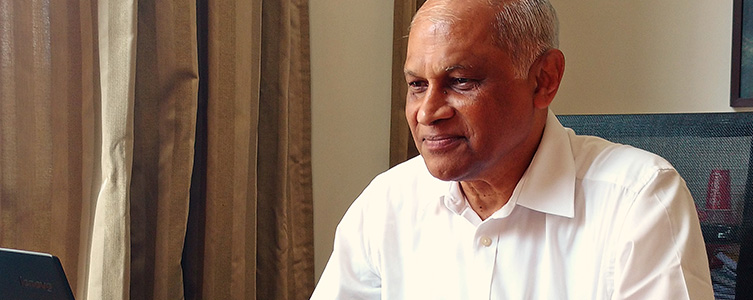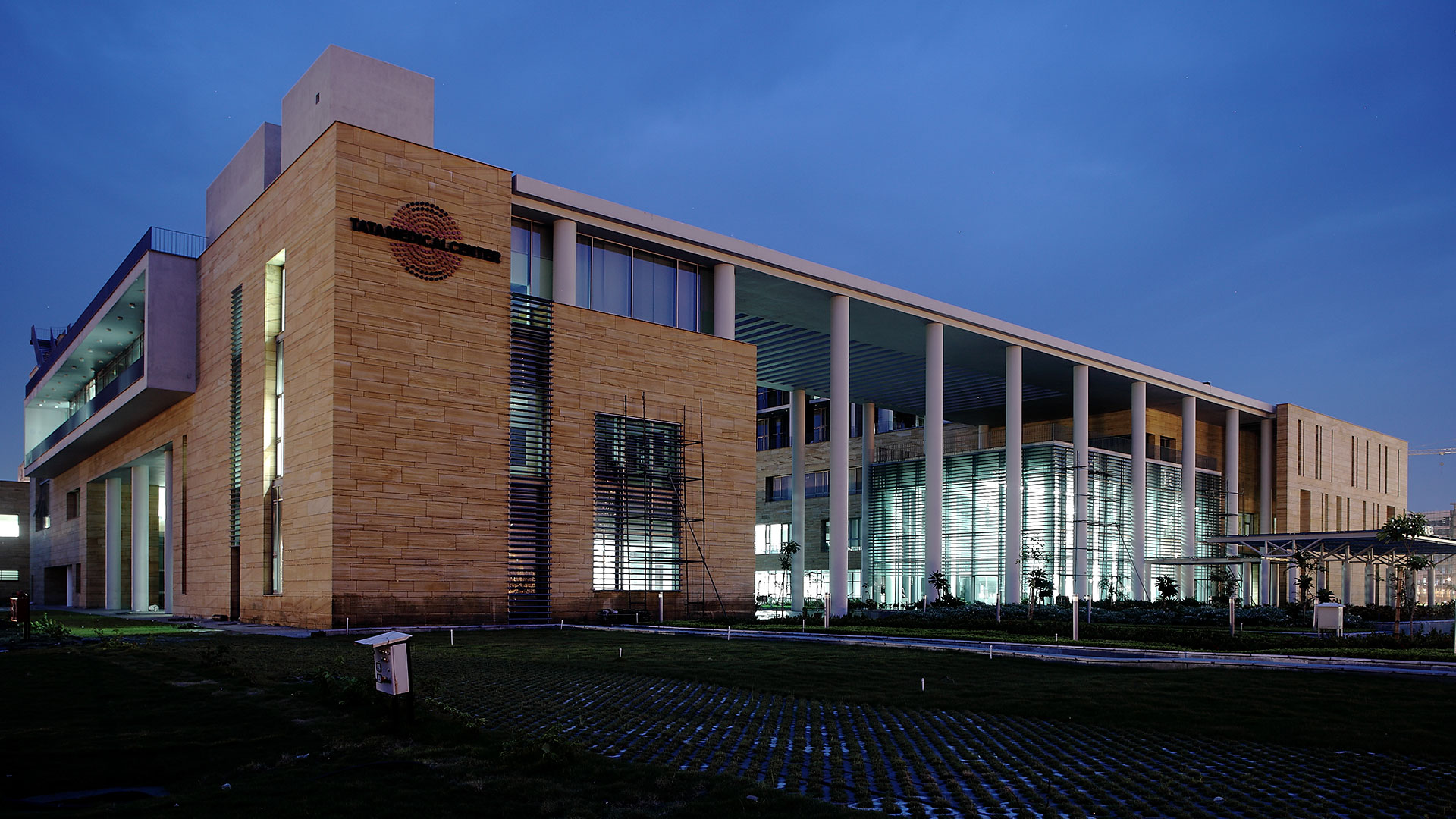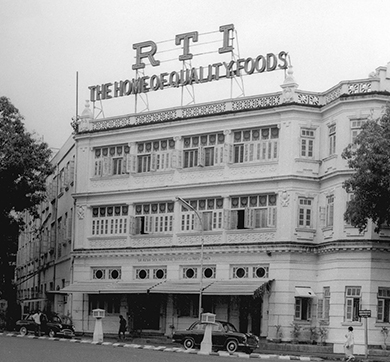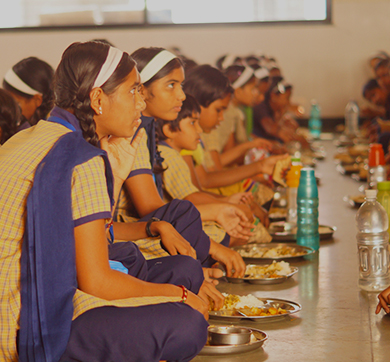June 2018 | 1735 words | 7-minute read
In the years since its inception, the Tata Medical Center (TMC) has made a heartwarming difference in India's seemingly desperate fight against cancer, through a commitment to high-quality treatment, dedication to the task, and a culture of people-spirited healthcare.
Set up in Kolkata in 2011, TMC has helped ease the cancer-care burden of a region where facilities to deal with the disease are still far from adequate. When the second phase of infrastructure and building is complete, the Center will have increased its number of beds from 183 to 425 and will be better equipped than before to treat those who come through its doors: approximately 1,000 outpatients a day and 17,000 new patients a year. TMC’s director, Dr Mammen Chandy, is sure that the Center’s expansion will bring benefits all around, in the care and treatment of cancer and with the research and training programmes that the hospital undertakes. Edited excerpts from the interview:
It’s coming up to seven years since TMC was established. How has the Center grown and evolved over this period?
TMC has witnessed phenomenal growth when measured by the number of patients we have treated during this period. We have had 183 beds up until now and at times it’s difficult to make space for a patient who needs admission. We turn away about 30 percent of patients, primarily because we cannot accommodate them, and the waiting time for complex surgeries can stretch to two months.
Our biggest gain is an ingrained sense of quality, love and compassion that is shown by everyone in the organisation, even the security personnel who receive an ambulance when it arrives at the hospital. Such care and concern for patients suggests that we have contributed to building an institution where our value system transcends professional excellence. Also, TMC is now recognised as a centre for training and we have about 100 trainees at any given time. We have carved a niche for ourselves in India’s eastern region.
Phase two of TMC will soon be completed. Beyond the additional infrastructure and the rest, what does this mean for the Center and its cancer-care mission?
The second phase will see a sizable increase in the number of beds at TMC. This means we can offer our services to more patients and, hopefully, reduce our waiting time for surgeries from two months to a month. Additionally, by fulfilling the requirement of becoming a 400-bed hospital we will be able to offer speciality training programmes. We don’t envisage any further expansion on this campus and will now take the satellite-centre approach to provide services to different regions in Northeast India.
A separate children’s floor is the most striking feature of TMC’s phase two expansion. Could you tell us a bit more about it?
Children probably have the highest cure rate for any cancer. With modern treatment techniques a child with acute leukaemia, for instance, has an 85 percent chance of being cured. There’s a special place at TMC for children: our Premashraya facility provides accommodation for children undergoing treatment and their families as well.
What has been TMC’s experience with the partnerships it has forged? How did the collaboration — to tackle the shortage of skilled professionals — with the Indian Institute of Technology, Kharagpur, happen?
India has a severe shortage of physicists, the people responsible for doing all the treatment planning on radiotherapy machines. We don’t have enough technologists who understand nuclear medicine, and we have a dearth of professionals in molecular microbiology. The lack all around has grave consequences, and we are trying to help in dealing with the deficit.
IIT Kharagpur has the vision and perception to realise that students graduating from educational institutions should be equipped with skill sets that are useful to humanity. That’s why the institute decided to collaborate with us, to bridge the human resource gap between medical science and technology. I am confident that this link between academia and TMC will result in faster delivery and better use of medical technology.

Collaboration among Tata companies and institutions is the theme of the much spoken about ‘One Tata’ concept. How has TMC contributed to increasing such collaborations and making them work to its advantage?
For us, the shining example here is the collaboration between Tata Consultancy Services (TCS) and TMC. We have one of the finest medical information systems in the country, and this a product of the teamwork between our doctors and the company’s soft ware professionals. We truly value this intellectual partnership and it is continuing, with TCS providing us disaster recovery software as well as contributing Rs. 750 million for the Tata Translational Cancer Research Centre (TTCRC).
Modern diagnosis depends heavily on next-generation DNA sequencing, which in turn relies heavily on informatics. Machines will spew out the data; you have to analyse this and provide it in a meaningful format. TCS will help us link biology to informatics: it will provide appropriate soft ware solutions — in clinical trials, for example — and it will assist us in research.
All of the group companies have also been extremely supportive of TMC: concessional pricing for steel, free satellite television for patients admitted to the hospital and enormous CSR support for the expansion and patient care. Tata Projects Ltd, Tata Consulting Engineers and Voltas are giving us exceptional service for the Phase II expansion.
What benefits will accrue from digitisation and data analysis in the years ahead?
I’m hoping that the software developed by TCS can become a platform for India’s National Cancer Grid (a network of cancer centres, research institutes, patient groups and charitable institutions) as well as the Tata Trusts. This will be highly beneficial when a patient goes from one centre to another for treatment, since the doctor can quickly come to grips with the diagnosis and treatment given up to that point. Another patient-friendly initiative from TCS is the ‘digital nerve centre’, or DiNC, that will connect the big cancer hospitals in the country. You can seek appointments to any of the hospitals through the DiNC system, which also helps in tracking the treatment history of patients. We are training doctors to advise cancer patients through this online system.
What sort of effect will artificial intelligence and robotics have on cancer treatment in general and on institutions like TMC? What about other cutting-edge developments in cancer care?
Tata Trusts recently gifted us the da Vinci Surgical System, which enables doctors to perform minimally invasive cancer operations. This will go a long way in providing patient comfort and post-operative relief. As for the future, informatics or big data analysis will play a significant role in determining lines of cancer treatment.
How has TTCRC, which is a TMC brainchild, been faring? Have the outcomes expected of the initiative been positive?
Thus far, we have not been able to harness the full potential of TTCRC, primarily because we lacked the space and infrastructure. However, with a new building and state-ofthe-art equipment, the research centre will be able to contribute more in cancer treatment. TTCRC already has an initiative — the ‘Indian childhood collaborative leukaemia group’, or ICICLE — through which children with lymphatic leukaemia are treated by way of a uniform protocol across the country.
Cancer rates in India have been rising steadily and alarmingly for a while now. What, in your view, are the three principal priority points for the country in tackling its cancer crisis?
Most importantly, India needs an active preventive oncology programme to educate the populace about the risks of smoking, obesity and the like, about spotting the warning signs of cancer, and about how to seek proper treatment. Next in the order of importance is increasing capacity and that’s where organisations such as Tata Trusts have stepped in to help. Finally, we need to use technology optimally to improve outcomes. If we do all of this, we can make a difference.
Is cancer more prevalent among the urban populace?
I don’t think that’s true; it’s across the board. The number of people in the 50-60 age bracket is increasing steadily and in this age group the risk of cancer is quite high. I think part of the reason for the higher incidence of the disease is demographic changes and longer life spans.
The ‘market’ for cancer diagnosis and treatment seems to be booming in urban India. What do we need to watch out for in terms of regulation and delivery?
The biggest problem that healthcare in India faces is the so-called corporatisation of medical care. While this has certainly augmented the country’s healthcare infrastructure, it has resulted in a paradigm shift — from doctor-patient to doctor-client. When you become a corporate, you have shareholders, you have dividends to pay out, you have loans to tide over. And these factors contribute to the pressure to be financially viable.
In all my professional life, I never faced any pressure to conduct unnecessary investigations, or operate on a patient who did not need surgery. What we are seeing today is total commercialisation and we, the doctors, are to some extent responsible for it. People no longer view a doctor as somebody who is sincere, dedicated and hardworking, as somebody who will keep the patient’s best interests in mind. Rather, they see the doctor driving up in a BMW and say, ‘Yes, he is making money out of me.’ There is a complete shift in perception and that has come about partly due to the very high salaries that doctors demand and receive.
What are the main challenges TMC faces in everyday cancer care and treatment and in realising its longterm vision?
The biggest challenge today for us is, perhaps, to recruit and retain talent that believes in the values and ethos of the institution. In my opinion, faith in the institution is the bedrock of TMC’s growth and the quality of treatment and care that it offers.
What are your best memories of your time as head of TMC?
When I came here seven years ago, the Center was an under-construction project. I’m proud that we have been able to create an institution that is making a difference in the lives of people in the eastern part of India. I also value the trust and respect I get from virtually every class of staff, and I continue to enjoy my clinical work and teaching as well. Overall, it has been a fulfilling journey so far.







